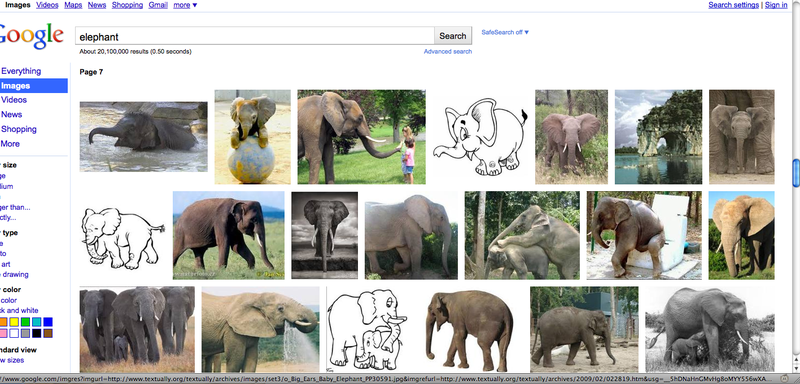How To Make A Stuffed Animal Pattern From Scratch

Editor's Note: This serial of posts became a volume!
Stuffed Animals: From Concept to Construction was published by Distraction Crafts in 2013.
+++++
I'1000 so glad that y'all are as excited as I am to delve into the topic of soft toy blueprint! I find this subject area totally arresting and I am ever learning new ways to design and construct softies. Please go along calculation your own knowledge at the stop of these posts and so that we tin all refer back and gain new skills.
Today I want to show how to draft a design for a very simple soft toy, what I would telephone call an outline toy. I am going to be making a simple elephant softie.
Ane of the offset steps in creating a softie pattern is distilling the animal's shapes to the essentials. What do you need to have in order for the viewer to know that y'all are making an elephant?
I began by doing a little visual research. I used Google Images to observe some skillful photos. Here are is what came upwardly in my image search for "elephant."

From here I started sketching, trying to notice the bones shapes and the most important features.


When designign a new sofite I like to as well accept a look at commercially produced blimp animals because these show me how other artists have already simplified the creature. Here is what came up in my epitome search for "elephant blimp animals."

From here I did some more sketching.

I assure you that you lot do non need superb drawing skills to be able to go through this process. What yous are aiming for is a adept, solid line drawing of the animal in contour, almost similar a page from a coloring volume. Just a solid, confident line.
An outline toy tin can also be head on, similar this siamese cat.
It is okay to exaggerate the most essential elements like the elephant'southward body and wide feet.
Next, I transfer the profile drawing to freezer paper. I depict the ears and the tail and any other parts, too.
Cut out the pattern pieces and characterization them all with the name of the blueprint, what slice each 1 is, and how many you'll need of each one and whatever other relevant information. Also, be sure to mark a 1"-2" spot that you will leave open for turning and stuffing later. Here is how my pattern pieces expect:


Iron the freezer paper to some fabric. I used gray wool felt.
I desire to attach the ears now considering I want them to be car sewn and so that the seam will be neat and potent. I am going to attach them through a slit in the trunk pieces. With a marker I mark the location of the slit. I pull off the pattern piece and cut the slit.

And then, I slide the edge of one ear into the opening in the right side of one body piece, pivot it in identify and sew across the opening, trapping the ear in the seam. The ears on my mouse ornament pattern as well employs this technique if y'all'd similar to effort it.
Now readhere the blueprint piece.
I'm also going to trap the top of the tail in the seam so that information technology will be auto sewn in place. I identify the tail within the trunk with just the tip sticking out by the edge of the pattern. Pin it in place so that information technology will be trapped between the two trunk pieces when I stitch around the elephant.
At present pivot the body pieces together and run up around, with the freezer paper all the same attached so that yous can accurately sew together the outline of the pattern. Here it is all stitched up:
 Trim i/8" from the stitching.
Trim i/8" from the stitching.

Clip the curves. Plow, stuff, close the opening with a neat ladder stitch.
If you demand to add whatever other embelishments like embroidering a oral fissure or making a yarn mane, you can add them at present. For the elephant, I am going to use some textile glue to adhere felt circles for eyes and little rounded triangle of pinkish felt for a mouth. You lot could also run up these in identify if you lot wanted to.

This is the kind of toy that even a child could make – in fact making simple softies with y'all children is a really fun way to spend an afternoon. If you decide to design a elementary outline toy like this with your children, felt is a practiced cloth choice. Kids can handsew with a running stitch effectually the right sides of the outline considering felt doesn't fray. A glue stick is an easy way to rapidly add any embelishments before kids' patience runs out.
Or take one of your kid's drawings and use that as the outline! Make them a unique toy based on one of their original designs.
Then, take you made a simple outline toy? Do yous have any thoughts or ideas to add? Please add your voice to the discussion then that we can learn from you!
And if y'all have never drafted an original soft toy blueprint, this is a adept way to brainstorm! It isn't besides daunting and you will end up with something totally original. I think you'll bask the procedure.
It is non a terribly big bound to get from here to a truly three-dimensional softie with 4-legs and a rounded head. What does it take? A head gusset and an underbody. Ii large topics we can effort to tackle presently!
Source: https://whileshenaps.com/2011/01/elements-of-soft-toy-design-pattern-drafting-for-a-simple-outline-toy.html
Posted by: peoplessyrument82.blogspot.com

0 Response to "How To Make A Stuffed Animal Pattern From Scratch"
Post a Comment